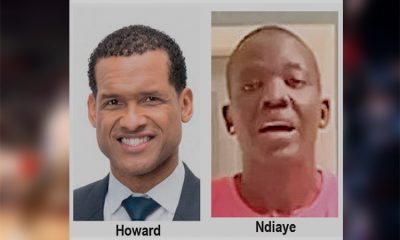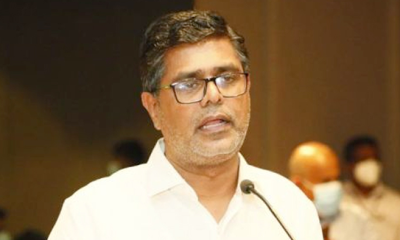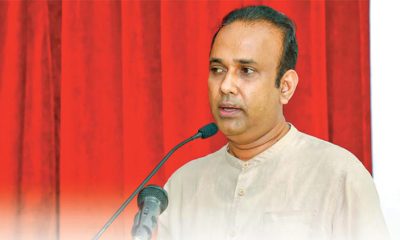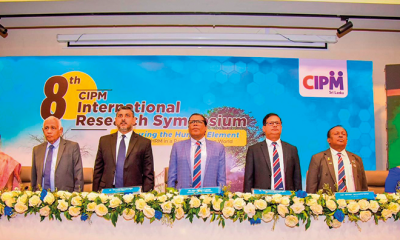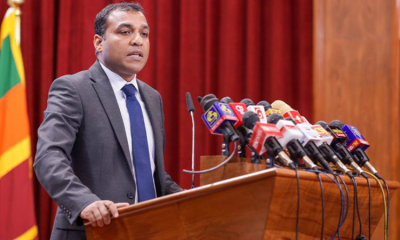Features
Precision measurement shakes world of science
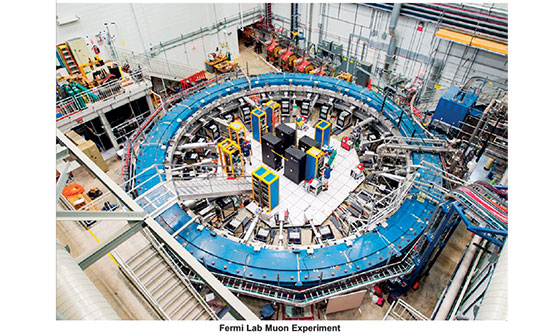
By Prof. Kirthi Tennakone
ktenna@yahoo.co.uk
National Institute of Fundamental Studies
Precision measurements have transformed science, influenced our way of thinking and impacted technology. A recent experiment conducted at the Fermi National Accelerator Laboratory, in the United States, poses questions regarding how nature operates at the deepest level. The experiment measured the magnet-like property of the elementary particle named muon, giving a numerical value to a quantity termed the g-factor. According to the most successful theory humans have devised, known as the Standard Model, this factor should be 2.0023318362. The experiment planned for decades has found that the measured value is 2.0023318412.
Why is a discrepancy in the eighth decimal place of a measurement, regarded a tantalising issue to agitate the world of science?
Before going into details of this experiment, it is interesting to recollect landmark examples of previous measurements that revolutionised the world and how definitive unvarying units have been adopted to do measurements.
Precision measurements: A few examples
One of the greatest precision measurements in the ancient world was invoked in planning the construction of Yoda Ela to carry water from Kalawewa to tanks in Anuradhapura. The slope of the 87 km channel measures less than 10 cm per kilometer!
Today, non-contact infrared thermometers instantly assess our body temperature, when we enter a supermarket. The first precise temperature measuring device, the so-called mercury-in-glass thermometer was invented by the Dutchman Daniel Fahrenheit in 1709 and the medical version by Thomas Allbut after a century. Later on, much more accurate temperature recording instruments were introduced, permitting determination of the temperature of ovens, planets, stars and the universe itself. The increased precision of temperature measurement unrivalled fundamental knowledge and elevated the quality of life. The thermometer has saved many lives, and cosmic background temperature measurement convinced us of Big Bang origin of the universe.
In mid-1800s astronomers measured minute deviations in the orbit of Uranus. The French mathematician Joseph LeVerrier, performed an unbelievably precise calculation and pointed out that the anomaly was due to the existence of another planet. He predicted that if astronomers point their telescopes to a certain point in the sky at a time he had calculated, the planet could be seen. This is how Neptune was discovered – confirming the preciseness of LeVerrier’s calculation! The ability to deploy exploratory robots to chosen locations on Moon or Mars rely on accuracy of such calculations, performed today with computers. LeVerrier did his laborious calculation manually!
Verification by observation and measurement is the ultimate test of any scientific theory. Unlike in other human affairs, individual opinions and politics entail no relevance. When Albert Einstein formulated his famous theory of general relativity, test he proposed was to measure the bending of light by gravity of the sun, seen as a minute change in the apparent position of a star during the time of a total solar eclipse. A measurement conducted during 1918 solar eclipse, visible to the island of Principe on African coast, agreed with his prediction, but he had to await further confirmation during the next solar eclipse that occurred in 1920.
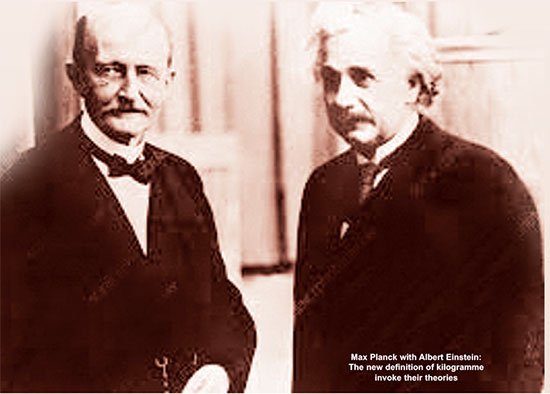 Collisions of black holes in distant universe generate gravitational waves disturbing space-time itself, causing minute changes in distance between positions on the globe. Gravitational wave detectors are sensitive enough to record changes in kilometer distances to an accuracy of trillion billionth of a meter.
Collisions of black holes in distant universe generate gravitational waves disturbing space-time itself, causing minute changes in distance between positions on the globe. Gravitational wave detectors are sensitive enough to record changes in kilometer distances to an accuracy of trillion billionth of a meter.
Modern fundamental science stands firm and progress on basis of ever increasing accuracy of measurements.
Units of measurement
Reliable and unambiguous measurements require fixed unvarying standards to be used as units. In the 12th century, the Royal Court of England, pleaded with King Henry I to tell what the length of the yard was. The King stretched his arms horizontally and said, “It is the distance between my nose and the thumb – a convenient length to match the size of the human body but not an accurate unvarying standard. After the French revolution, the Academy of Sciences in Paris decided to adopt a decimal metric system of units to ease measures in business and engineering. The metric unit of length ‘meter’ was originally determined as one ten- millionth of the shortest distance between North Pole and the Equator. As the extent of this length is hard to determine repeatedly, in 1779 meter was redefined as the length of a metal bar secured at the International Bureau of Weights and Measures in Paris. Likewise, the unit of mass, the kilogramme was fixed as that of a cylinder of metal kept in the Bureau. The definition of the unit of time, the second, relied on the period of rotation of the earth (one day) divided into hours, minutes and seconds in the usual way.
The units of length, mass and time defined as above are not guaranteed to remain unchanged. The standard of length, the metal bar kept in Paris could slightly warp and cylinder defining the kilogramme may lose weight owing to evaporation of the metal or gain weight by deposition of dust. Earthquakes and falling meteors alter the rate of rotation of the earth.
It is amazing that nature has provided a method of permanently fixing the units of time, length and mass so that standards remain unvarying and same everywhere whether it is on earth, mars or any other remote corner of the universe. There are unchanging constants in nature and the standards of time length and mass can be fixed in terms these quantities.
The modern international standard unit of time is defined as a 9.1926331770 billion periods of a specific oscillation of the cesium atom. Nearly 9 million odd number is chosen to adjust approximate agreement with the previous definition of the unit of time based on earth’s period of rotation.
The velocity of light in vacuum is constant and independent of the motion of the light source, according to Einstein’s theory of relativity. Once a velocity and time are fixed, a length can be fixed. Thus the international standard of length is now defined as the distance traversed by light in vacuum in 1/299 792 458 of a second. Here again this odd fraction is adopted to ensure good agreement with previous definition of the unit of time – the second.
New International Standard of Kilogram – Effective from 20th May 2019
Although the units of time and length have been redefined in terms of fundamental constants, until 20th May 2019, the standard of mass (weight) continued to be the chunk of metal kept in Paris. The definition of mass based on this standard is unsatisfactory because the metal chunk could lose or gain mass owing to natural causes. Mass can also be defined in terms of another constant of nature termed the Planck constant. The German Physicist Max Planck and Albert Einstein derived this constant to formulate the quantum theory. The Planck constant has dimensions of an energy multiplied by time. Einstein’s famous equation––Energy = mass x square of the velocity of light––allows unit of mass to be defined in terms of energy. Alternatively fixing the standard of mass is equivalent to fixing the value of the Planck constant.
After many discussions on fixing the value of the kilogramme, lasting for more than a decade, the Meeting of the International Bureau of Weights and Measures held in Versailles, in November 2018, unanimously voted to fix the value of the Planck constant as 6.62607015 kg square meters per second. As in the cases of the units of time and length, this particular value of Planck constant was chosen so that the value of the kilogramme agree with previous definition. A procedure was also established to calibrate the kilogramme using a device known as the Kibble Balance. The new definition of the kilogramme was declared to be effective from 20th May 2019.
The modern units of time, length and mass have the same meaning to us as well as aliens wherever they exist;they can decipher our units!
Fermi lab Experiment: Possibility of something hidden deepest in nature
The Fermi Lab particle accelerator, near, Chicago in the United States, and the more powerful sister machine, the Large Hadron Collider in Geneva are the world’s leading particle accelerators, built at an exorbitant cost to understand the ultimate constitution of matter and forces governing their interactions. Accelerators energise protons or electrons and impinge them on each other and the products of the crash, yield a wealth of information.
Based on such experiments carried out at accelerator laboratories since early 1960s, we know that all matter around us is constituted of three particles–– up-quark, down quark and the electron, carrying electric charges 2/3, -1/3 and -1 in units of charge of the electron. Though not found in ordinary matter, experiments indicate occurrence of other brands quarks and electron like objects. Up-quark, down quark and the electron, have two other heavier companions each. Nobody knows why quarks and electron like objects, known as leptons, belong to families with three members. However, a theory known as the Standard Model accounts for forces between these particles mediated by another set of quantum objects known as bosons. The theory of the Standard Model is so general; in principle, it encompasses,large portion of physics, the whole of chemistry and therefore biology as well. Nevertheless, it has several discrepancies. The major one is that the model cannot accommodate gravity and the theory of gravity stands separate unmarried to the Standard Model as Einstein’s General Theory of Relativity. Experiments conclusively demonstrate that quarks and electron like particles of opposite charge also exist as demanded by the theory, but bulk matter made out these of these entities (antimatter) is not seen in the universe. Another anomaly is the existence of a triad of particles without electric charge known as neutrinos. The standard model could accommodate neutrinos if they have zero mass, but now they are known to be endowed with miniscule masses. Again observed faster expansion of the universe imply that the space is filled other forms of matter and energy not accounted by the Standard Model.
Science has furthered longer leaps, not by finding more and more evidence to support a favourite theory but by focusing greater attention on things refuting it.
Finding a disagreement with a theory is more important than dozens of supportive evidence.
Last week, the scientific world was shaken by an announcement of the Fermi Lab that the result of an experiment, suggested another glaring contradiction of the Standard Model.
Anomaly challenging established science
Electron and its 206 times heavier companion particle muon in the lepton family behave as miniature magnets and their magnetic properties are measured by a parameter referred to as the g-factor. As a result of magnetism these particles wobble in a strong magnetic field, similar to the motion of a spinning top just before it falls. Fermi lab experiment studied this motion using gigantic magnet, enabling evaluation of the g-factor of the muon to an utmost precision. The value they determined experimentally, deviate from the number predicted by the celebrated Standard Model by one part per one hundred million. Result confirms a previous measurement and therefore points to an anomaly. Scientific world is excited, because it may be a clue to disclose a deeper secret of nature, bearing profound implications. Possibly a crack in the Standard Model – a gift to amend the Standard Model and go beyond.
Why we should engage in advanced studies to learn secrets of nature?
One might ask what’s the use of this brain-teasing science, which seems to be of no relevance to the majority of the people, is. This query, in some sense, is equivalent to the question; what is the use of Totagomuwe Sri Ruhula Thera’s Salalihini Sandesaya or Shakespeare’s A Mid-Summer Nights Dream to people’s economic aspirations? The answer to both the questions is that these may not have immediate practical benefit to the average man or woman, but their value to humanity has been enormous. An average human being is benefitted most by overall advancement of the civilization.
In an era of telemedia which display everything hastily on two dimensional screens, society tends to seek quick answers to most issues and end-up with marginal solutions, refraining from deep contemplation
Every nation needs to encourage curiosity and imagination motivating advanced fundamental science, arts and literature. In reality those nations who have successfully earned economic returns from technology are the ones who excelled in the former themes.
Years ago, only Europe and the United States of America engaged in advanced precision experimentation and theoretical calculations to understand hard unresolved puzzles. Now, the developing countries have also realised the importance of such endeavors.
In fact, Sri Lanka was one of the first countries in Asia to recognise the importance of theoretical and mathematical studies and establish an Institute for the purpose; the proposal to set-up the Institute of Fundamental Studies was drafted by a Committee, headed by the late Prof. M.W. Mailvagnam, in 1969, on instructions of the Minister of Scientific Affairs M.D. H. Jayewardhana.
Sri Lanka possess talented young minds to tap and we need to provide them with opportunities to comprehend and pursue advanced frontier studies of the level that agitated the scientific world the past week; it is the duty and mandate of the institutions established for the cause to do so.
Features
The heart-friendly health minister

by Dr Gotabhya Ranasinghe
Senior Consultant Cardiologist
National Hospital Sri Lanka
When we sought a meeting with Hon Dr. Ramesh Pathirana, Minister of Health, he graciously cleared his busy schedule to accommodate us. Renowned for his attentive listening and deep understanding, Minister Pathirana is dedicated to advancing the health sector. His openness and transparency exemplify the qualities of an exemplary politician and minister.
Dr. Palitha Mahipala, the current Health Secretary, demonstrates both commendable enthusiasm and unwavering support. This combination of attributes makes him a highly compatible colleague for the esteemed Minister of Health.
Our discussion centered on a project that has been in the works for the past 30 years, one that no other minister had managed to advance.
Minister Pathirana, however, recognized the project’s significance and its potential to revolutionize care for heart patients.
The project involves the construction of a state-of-the-art facility at the premises of the National Hospital Colombo. The project’s location within the premises of the National Hospital underscores its importance and relevance to the healthcare infrastructure of the nation.
This facility will include a cardiology building and a tertiary care center, equipped with the latest technology to handle and treat all types of heart-related conditions and surgeries.
Securing funding was a major milestone for this initiative. Minister Pathirana successfully obtained approval for a $40 billion loan from the Asian Development Bank. With the funding in place, the foundation stone is scheduled to be laid in September this year, and construction will begin in January 2025.
This project guarantees a consistent and uninterrupted supply of stents and related medications for heart patients. As a result, patients will have timely access to essential medical supplies during their treatment and recovery. By securing these critical resources, the project aims to enhance patient outcomes, minimize treatment delays, and maintain the highest standards of cardiac care.
Upon its fruition, this monumental building will serve as a beacon of hope and healing, symbolizing the unwavering dedication to improving patient outcomes and fostering a healthier society.We anticipate a future marked by significant progress and positive outcomes in Sri Lanka’s cardiovascular treatment landscape within the foreseeable timeframe.
Features
A LOVING TRIBUTE TO JESUIT FR. ALOYSIUS PIERIS ON HIS 90th BIRTHDAY

by Fr. Emmanuel Fernando, OMI
Jesuit Fr. Aloysius Pieris (affectionately called Fr. Aloy) celebrated his 90th birthday on April 9, 2024 and I, as the editor of our Oblate Journal, THE MISSIONARY OBLATE had gone to press by that time. Immediately I decided to publish an article, appreciating the untiring selfless services he continues to offer for inter-Faith dialogue, the renewal of the Catholic Church, his concern for the poor and the suffering Sri Lankan masses and to me, the present writer.
It was in 1988, when I was appointed Director of the Oblate Scholastics at Ampitiya by the then Oblate Provincial Fr. Anselm Silva, that I came to know Fr. Aloy more closely. Knowing well his expertise in matters spiritual, theological, Indological and pastoral, and with the collaborative spirit of my companion-formators, our Oblate Scholastics were sent to Tulana, the Research and Encounter Centre, Kelaniya, of which he is the Founder-Director, for ‘exposure-programmes’ on matters spiritual, biblical, theological and pastoral. Some of these dimensions according to my view and that of my companion-formators, were not available at the National Seminary, Ampitiya.
Ever since that time, our Oblate formators/ accompaniers at the Oblate Scholasticate, Ampitiya , have continued to send our Oblate Scholastics to Tulana Centre for deepening their insights and convictions regarding matters needed to serve the people in today’s context. Fr. Aloy also had tried very enthusiastically with the Oblate team headed by Frs. Oswald Firth and Clement Waidyasekara to begin a Theologate, directed by the Religious Congregations in Sri Lanka, for the contextual formation/ accompaniment of their members. It should very well be a desired goal of the Leaders / Provincials of the Religious Congregations.
Besides being a formator/accompanier at the Oblate Scholasticate, I was entrusted also with the task of editing and publishing our Oblate journal, ‘The Missionary Oblate’. To maintain the quality of the journal I continue to depend on Fr. Aloy for his thought-provoking and stimulating articles on Biblical Spirituality, Biblical Theology and Ecclesiology. I am very grateful to him for his generous assistance. Of late, his writings on renewal of the Church, initiated by Pope St. John XX111 and continued by Pope Francis through the Synodal path, published in our Oblate journal, enable our readers to focus their attention also on the needed renewal in the Catholic Church in Sri Lanka. Fr. Aloy appreciated very much the Synodal path adopted by the Jesuit Pope Francis for the renewal of the Church, rooted very much on prayerful discernment. In my Religious and presbyteral life, Fr.Aloy continues to be my spiritual animator / guide and ongoing formator / acccompanier.
Fr. Aloysius Pieris, BA Hons (Lond), LPh (SHC, India), STL (PFT, Naples), PhD (SLU/VC), ThD (Tilburg), D.Ltt (KU), has been one of the eminent Asian theologians well recognized internationally and one who has lectured and held visiting chairs in many universities both in the West and in the East. Many members of Religious Congregations from Asian countries have benefited from his lectures and guidance in the East Asian Pastoral Institute (EAPI) in Manila, Philippines. He had been a Theologian consulted by the Federation of Asian Bishops’ Conferences for many years. During his professorship at the Gregorian University in Rome, he was called to be a member of a special group of advisers on other religions consulted by Pope Paul VI.
Fr. Aloy is the author of more than 30 books and well over 500 Research Papers. Some of his books and articles have been translated and published in several countries. Among those books, one can find the following: 1) The Genesis of an Asian Theology of Liberation (An Autobiographical Excursus on the Art of Theologising in Asia, 2) An Asian Theology of Liberation, 3) Providential Timeliness of Vatican 11 (a long-overdue halt to a scandalous millennium, 4) Give Vatican 11 a chance, 5) Leadership in the Church, 6) Relishing our faith in working for justice (Themes for study and discussion), 7) A Message meant mainly, not exclusively for Jesuits (Background information necessary for helping Francis renew the Church), 8) Lent in Lanka (Reflections and Resolutions, 9) Love meets wisdom (A Christian Experience of Buddhism, 10) Fire and Water 11) God’s Reign for God’s poor, 12) Our Unhiddden Agenda (How we Jesuits work, pray and form our men). He is also the Editor of two journals, Vagdevi, Journal of Religious Reflection and Dialogue, New Series.
Fr. Aloy has a BA in Pali and Sanskrit from the University of London and a Ph.D in Buddhist Philosophy from the University of Sri Lankan, Vidyodaya Campus. On Nov. 23, 2019, he was awarded the prestigious honorary Doctorate of Literature (D.Litt) by the Chancellor of the University of Kelaniya, the Most Venerable Welamitiyawe Dharmakirthi Sri Kusala Dhamma Thera.
Fr. Aloy continues to be a promoter of Gospel values and virtues. Justice as a constitutive dimension of love and social concern for the downtrodden masses are very much noted in his life and work. He had very much appreciated the commitment of the late Fr. Joseph (Joe) Fernando, the National Director of the Social and Economic Centre (SEDEC) for the poor.
In Sri Lanka, a few religious Congregations – the Good Shepherd Sisters, the Christian Brothers, the Marist Brothers and the Oblates – have invited him to animate their members especially during their Provincial Congresses, Chapters and International Conferences. The mainline Christian Churches also have sought his advice and followed his seminars. I, for one, regret very much, that the Sri Lankan authorities of the Catholic Church –today’s Hierarchy—- have not sought Fr.
Aloy’s expertise for the renewal of the Catholic Church in Sri Lanka and thus have not benefited from the immense store of wisdom and insight that he can offer to our local Church while the Sri Lankan bishops who governed the Catholic church in the immediate aftermath of the Second Vatican Council (Edmund Fernando OMI, Anthony de Saram, Leo Nanayakkara OSB, Frank Marcus Fernando, Paul Perera,) visited him and consulted him on many matters. Among the Tamil Bishops, Bishop Rayappu Joseph was keeping close contact with him and Bishop J. Deogupillai hosted him and his team visiting him after the horrible Black July massacre of Tamils.
Features
A fairy tale, success or debacle

Sri Lanka-Singapore Free Trade Agreement
By Gomi Senadhira
senadhiragomi@gmail.com
“You might tell fairy tales, but the progress of a country cannot be achieved through such narratives. A country cannot be developed by making false promises. The country moved backward because of the electoral promises made by political parties throughout time. We have witnessed that the ultimate result of this is the country becoming bankrupt. Unfortunately, many segments of the population have not come to realize this yet.” – President Ranil Wickremesinghe, 2024 Budget speech
Any Sri Lankan would agree with the above words of President Wickremesinghe on the false promises our politicians and officials make and the fairy tales they narrate which bankrupted this country. So, to understand this, let’s look at one such fairy tale with lots of false promises; Ranil Wickremesinghe’s greatest achievement in the area of international trade and investment promotion during the Yahapalana period, Sri Lanka-Singapore Free Trade Agreement (SLSFTA).
It is appropriate and timely to do it now as Finance Minister Wickremesinghe has just presented to parliament a bill on the National Policy on Economic Transformation which includes the establishment of an Office for International Trade and the Sri Lanka Institute of Economics and International Trade.
Was SLSFTA a “Cleverly negotiated Free Trade Agreement” as stated by the (former) Minister of Development Strategies and International Trade Malik Samarawickrama during the Parliamentary Debate on the SLSFTA in July 2018, or a colossal blunder covered up with lies, false promises, and fairy tales? After SLSFTA was signed there were a number of fairy tales published on this agreement by the Ministry of Development Strategies and International, Institute of Policy Studies, and others.
However, for this article, I would like to limit my comments to the speech by Minister Samarawickrama during the Parliamentary Debate, and the two most important areas in the agreement which were covered up with lies, fairy tales, and false promises, namely: revenue loss for Sri Lanka and Investment from Singapore. On the other important area, “Waste products dumping” I do not want to comment here as I have written extensively on the issue.
1. The revenue loss
During the Parliamentary Debate in July 2018, Minister Samarawickrama stated “…. let me reiterate that this FTA with Singapore has been very cleverly negotiated by us…. The liberalisation programme under this FTA has been carefully designed to have the least impact on domestic industry and revenue collection. We have included all revenue sensitive items in the negative list of items which will not be subject to removal of tariff. Therefore, 97.8% revenue from Customs duty is protected. Our tariff liberalisation will take place over a period of 12-15 years! In fact, the revenue earned through tariffs on goods imported from Singapore last year was Rs. 35 billion.
The revenue loss for over the next 15 years due to the FTA is only Rs. 733 million– which when annualised, on average, is just Rs. 51 million. That is just 0.14% per year! So anyone who claims the Singapore FTA causes revenue loss to the Government cannot do basic arithmetic! Mr. Speaker, in conclusion, I call on my fellow members of this House – don’t mislead the public with baseless criticism that is not grounded in facts. Don’t look at petty politics and use these issues for your own political survival.”
I was surprised to read the minister’s speech because an article published in January 2018 in “The Straits Times“, based on information released by the Singaporean Negotiators stated, “…. With the FTA, tariff savings for Singapore exports are estimated to hit $10 million annually“.
As the annual tariff savings (that is the revenue loss for Sri Lanka) calculated by the Singaporean Negotiators, Singaporean $ 10 million (Sri Lankan rupees 1,200 million in 2018) was way above the rupees’ 733 million revenue loss for 15 years estimated by the Sri Lankan negotiators, it was clear to any observer that one of the parties to the agreement had not done the basic arithmetic!
Six years later, according to a report published by “The Morning” newspaper, speaking at the Committee on Public Finance (COPF) on 7th May 2024, Mr Samarawickrama’s chief trade negotiator K.J. Weerasinghehad had admitted “…. that forecasted revenue loss for the Government of Sri Lanka through the Singapore FTA is Rs. 450 million in 2023 and Rs. 1.3 billion in 2024.”
If these numbers are correct, as tariff liberalisation under the SLSFTA has just started, we will pass Rs 2 billion very soon. Then, the question is how Sri Lanka’s trade negotiators made such a colossal blunder. Didn’t they do their basic arithmetic? If they didn’t know how to do basic arithmetic they should have at least done their basic readings. For example, the headline of the article published in The Straits Times in January 2018 was “Singapore, Sri Lanka sign FTA, annual savings of $10m expected”.
Anyway, as Sri Lanka’s chief negotiator reiterated at the COPF meeting that “…. since 99% of the tariffs in Singapore have zero rates of duty, Sri Lanka has agreed on 80% tariff liberalisation over a period of 15 years while expecting Singapore investments to address the imbalance in trade,” let’s turn towards investment.
Investment from Singapore
In July 2018, speaking during the Parliamentary Debate on the FTA this is what Minister Malik Samarawickrama stated on investment from Singapore, “Already, thanks to this FTA, in just the past two-and-a-half months since the agreement came into effect we have received a proposal from Singapore for investment amounting to $ 14.8 billion in an oil refinery for export of petroleum products. In addition, we have proposals for a steel manufacturing plant for exports ($ 1 billion investment), flour milling plant ($ 50 million), sugar refinery ($ 200 million). This adds up to more than $ 16.05 billion in the pipeline on these projects alone.
And all of these projects will create thousands of more jobs for our people. In principle approval has already been granted by the BOI and the investors are awaiting the release of land the environmental approvals to commence the project.
I request the Opposition and those with vested interests to change their narrow-minded thinking and join us to develop our country. We must always look at what is best for the whole community, not just the few who may oppose. We owe it to our people to courageously take decisions that will change their lives for the better.”
According to the media report I quoted earlier, speaking at the Committee on Public Finance (COPF) Chief Negotiator Weerasinghe has admitted that Sri Lanka was not happy with overall Singapore investments that have come in the past few years in return for the trade liberalisation under the Singapore-Sri Lanka Free Trade Agreement. He has added that between 2021 and 2023 the total investment from Singapore had been around $162 million!
What happened to those projects worth $16 billion negotiated, thanks to the SLSFTA, in just the two-and-a-half months after the agreement came into effect and approved by the BOI? I do not know about the steel manufacturing plant for exports ($ 1 billion investment), flour milling plant ($ 50 million) and sugar refinery ($ 200 million).
However, story of the multibillion-dollar investment in the Petroleum Refinery unfolded in a manner that would qualify it as the best fairy tale with false promises presented by our politicians and the officials, prior to 2019 elections.
Though many Sri Lankans got to know, through the media which repeatedly highlighted a plethora of issues surrounding the project and the questionable credentials of the Singaporean investor, the construction work on the Mirrijiwela Oil Refinery along with the cement factory began on the24th of March 2019 with a bang and Minister Ranil Wickremesinghe and his ministers along with the foreign and local dignitaries laid the foundation stones.
That was few months before the 2019 Presidential elections. Inaugurating the construction work Prime Minister Ranil Wickremesinghe said the projects will create thousands of job opportunities in the area and surrounding districts.
The oil refinery, which was to be built over 200 acres of land, with the capacity to refine 200,000 barrels of crude oil per day, was to generate US$7 billion of exports and create 1,500 direct and 3,000 indirect jobs. The construction of the refinery was to be completed in 44 months. Four years later, in August 2023 the Cabinet of Ministers approved the proposal presented by President Ranil Wickremesinghe to cancel the agreement with the investors of the refinery as the project has not been implemented! Can they explain to the country how much money was wasted to produce that fairy tale?
It is obvious that the President, ministers, and officials had made huge blunders and had deliberately misled the public and the parliament on the revenue loss and potential investment from SLSFTA with fairy tales and false promises.
As the president himself said, a country cannot be developed by making false promises or with fairy tales and these false promises and fairy tales had bankrupted the country. “Unfortunately, many segments of the population have not come to realize this yet”.
(The writer, a specialist and an activist on trade and development issues . )


